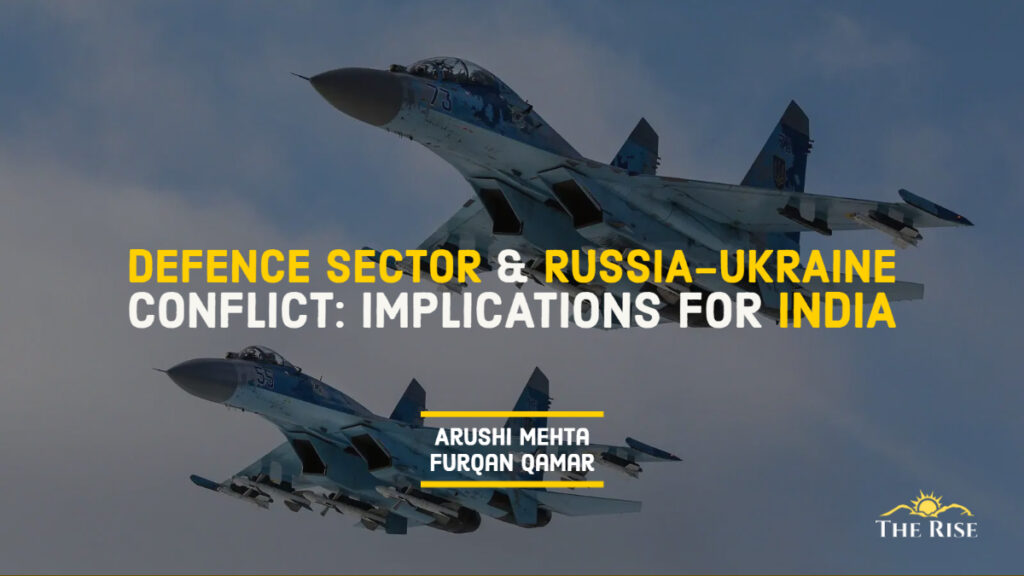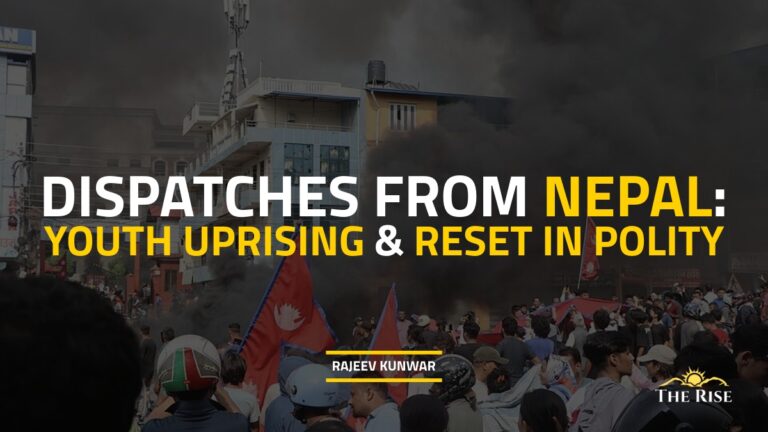Although several developed countries might propagate the idea that the conflicts and wars bring misery to humanity at large, they promote the idea of defence preparedness as a means and instrument of deterrence, and this ensures that their interests are served even during good times. Russia’s invasion of Ukraine has created all the needed threat perception amongst many a country to cause the global armament exports to flourish. Will the geopolitics permit, promote, and support India to capitalize on this export opportunity, or would it be prevented from doing so?
Russia’s attack on Ukraine, the continuation of the conflict into its eighth week, and consequent economic sanctions and embargo on Russia by the western world have caused a major humanitarian crisis of this century. The crisis has caused an economic catastrophe and exposed the vulnerabilities of the world economy. Humanitarian and economic implications apart, this crisis has tightened the sense of insecurities in many countries compelling them to rethink their defence spending.
As threat perception increases during the time of conflict and crisis, the focus on deterrents increases manifolds leading to massive expenditure and investment in the defence sector. For the producers and suppliers of the defence equipment, armament, training, and capacity buildings, the defence sector is a good and sustained source of not only revenue but also job creation and employment. It is mostly the developed countries that are the biggest beneficiaries. Even though they might propagate the idea that the conflicts and wars bring misery to humanity at large, they promote the idea of defence preparedness as a means and instrument of deterrence, and this ensures that their interests are served even during good times.
Indeed, it may be preposterous to claim that they might secretly desire to aggravate threat perceptions of countries to expand the demand for their own defence industry. They want the war to end and peace restored. But do they? The USA and many of its allies have been providing substantial military aid to Ukraine to enable it to put up an effective defence against the Russian aggression. This has, obviously, resulted in the business for the defence equipment manufacturers. Like most other wars, this one too appears advantageous for the leading weapon makers and exporters. Businesses providing defence supplies to both the warring nations are likely to rake in profits, that peace lovers might call vulgar.
Also Read: Fallouts of Financial Sanctions Against Russia
Although several developed countries might propagate the idea that the conflicts and wars bring misery to humanity at large, they promote the idea of defence preparedness as a means and instrument of deterrence, and this ensures that their interests are served even during good times.
With the heightened threat perception caused by the current conflict, many countries, that are not a party to the current crisis, are already contemplating substantial increases in their defence spending. Germany, which has so far been arguing for a drastic reduction in the defence budget to augment the development budget, for example, has announced to enhance its defence budget to 2 percent of its GDP from the present level of 1.5 percent. Japan also intends to increase its 2022 defence budget to more than 1 percent of its GDP for the first time since the 1960s (Klebnikov, 2022).
It should, therefore, be no surprise, that while the stock markets slid as Russia invaded Ukraine, the stock prices of defence equipment manufacturers saw a significant increase. They, in fact, outperformed the markets in expectation of increased orders leading to rise in their profitability (Chakraborty, 2022). The iShares U.S. Aerospace & Defence ETF, the largest of its kind with 33 equity holdings, has recorded a significant increase (Klebnikov, 2022). Prominent defence stocks like Raytheon Technologies, General Dynamics, Huntington Ingalls Industries, Lockheed Martin, and Northrop Grumman too have registered a substantial increase in their prices (Klebnikov, 2022; The Conversation, 2022).
Also read: Russia-Ukraine Conflict: Impact on Global Flow of Funds
Russia’s invasion of Ukraine has created all the needed threat perception amongst many a country to cause the global armament exports to flourish.
According to the World Bank, the global military expenditure during the year 2020 was USD 1.929 trillion or 2.36 percent of the global GDP (World Bank, n.d.) or about 10 percent of the US GDP (Neill, 2021). The top 5 countries in the world with the highest military expenditure in 2020 were the USA (778 billion USD), China (252 billion USD – estimated), India (72.9 billion USD), Russia (61.7 billion USD), and the United Kingdom (59.2 billion USD) (World Population Review, n.d.). In terms of military expenditure as a percentage of GDP, the top 5 countries during the year 2020 were South Africa (8.4 percent), Israel (5.6 percent), Russia (4.3 percent), USA (3.7 percent), and India (2.9 percent) (Szmigiera, 2021). India has, thus, been the third-largest spender on defence in absolute terms, and the fifth-largest spender in terms of defence expenditure as a percentage of GDP.
Russia’s invasion of Ukraine has created all the needed threat perception amongst many a country to cause the global armament exports to flourish. As a result, the defence expenditure of these and many other countries are likely to see a substantial increase in the future, as a result of which welfare measures of Governments may get squeezed.
The total global exports of arms during the year 2020 were to the tune of 23,677 million USD (SIPRI, n.d.). The five top countries in terms of the global share in arms exports during 2016-20 were the USA (37 percent), Russia (20 percent), France (8.2 percent), Germany (5.5 percent) and China (5.2 percent) (Wezeman et al., 2021). While Russia is at war, other major exporting countries are expected to benefit significantly. Similarly, the five top countries in terms of the global share in import of arms during the same period were Saudi Arabia (11 percent), India (9.5 percent), Egypt (5.8 percent), Australia (5.1 percent), and China (4.7 percent) (Wezeman et al., 2021). These are most likely to further expand their defence imports by compromising their welfare and development budgets.
Also Read: The Lessons for Taiwan from Russia-Ukraine Conflict
India in the Global Arms Trade
India was the second-largest importer of arms during the period 2016-20. Its import of arms during the year 2020 were 2813 million USD which jumped to 4414 million USD during the year 2021 (SIPRI, n.d.). This may see a further rise in the near future. The major exporters to India during the year 2020 were Russia (1241 million USD), France (749 million USD), the USA (411 million USD), Israel (108 million USD) and Germany (67 million USD). The direction of imports seems to have seen a shift as the major exporters to India during the year 2021 were France (2134 million USD), Russia (1392 million USD), the USA (425 million USD), Israel (225 million USD) and United Kingdom (UK) (137 million USD) (SIPRI, n.d.). Although Russia’s arms exports to India grew in the year 2021 over the year 2020 in absolute terms, it actually slid to second place (SIPRI, n.d.).
Though Russia still remains an important defence supplier to India, India is increasingly turning to other sources like the USA, France, and Israel for its military hardware and software requirements. This is in tune with India’s strategy of reducing dependence on any one source and diversifying technologies and suppliers. Global exports of arms are a very lucrative business and exporter countries try to promote their domestic industry and often lobby for them. India, being a major arms importer, remains a lucrative destination. Sensing disruption in supplies from Russia, the USA has been prodding India to procure more from the US (Business Standard, 2022).
You May Read: Decoding the Objectives of FM Wang Yi’s Visit to India
Russia remains important for India as a trusted and old supplier with a very long history. India is also dependent on Russia for the supply of spare parts and servicing of the equipment that it procured in the past. Russian military equipment constitutes over 50 percent of India’s overall military assets cutting across all three services (Congressional Research Service, 2021). These require periodic upgrades, maintenance, spare parts, and ancillary support. India might be hit hard if the financial sanctions disrupt the entire supply chain. India has so far managed to stave off sanctions under the US law called CAATSA (Countering America’s Adversaries Through Sanctions Act) which seeks to prevent countries from buying Russian weapons’ (Pandit, 2022).
During the recently concluded two-plus-two dialogue with the USA, India reportedly stressed the need to take up co-development and co-production of high-tech defence systems.
Also Read: Economic Implications of Russia-Ukraine Crisis
It is good that India has been supporting and encouraging domestic defence production and, thus, reducing its dependence on imports through the ambitious Atmanirbhar Bharat Abhiyan with a focus on Make in India. In most of the foreign procurement orders, there is a stipulation of technology transfer and involvement of domestic partners with production in India. India has a strong presence of defence manufacturing entities in the public sector in the form of Ordnance Factories and Hindustan Aeronautics Limited among other entities. The government has also opened up this sector to the private sector to some extent (PIB Delhi, 2021).
To boost its defence capabilities and encourage domestic production, the country had earlier approved banning the import of 108 military equipment in a phased manner (Shah, 2022). The ban on the import of 49 such equipment has already come into force by the end of 2021. The ban on the remaining 59 items is likely to become effective by December 2025 (Shah, 2022). Simultaneously, efforts are on to produce these 108 military equipment indigenously. These may include complex defence systems like sensors, simulators, sonars, radars, assorted weapons, helicopters, next-generation corvettes, airborne early warning and control systems, tank engines, medium power radars for mountains, medium-range surface-to-air missile systems, etc. (Shah, 2022).
During the recently concluded two-plus-two dialogue with the USA, India reportedly stressed the need to take up co-development and co-production of high-tech defence systems. Further, India and the USA have also decided to revitalize the “Defence Technology and Trade Initiative” between the two countries, which was launched in the year 2012 (Pandit, 2022). This, when materialized, is expected to boost defence cooperation between the two countries and also push domestic defence production in India.
Also Read: The Indian Economy: Stop the Slide…Before It Slips
India’s defence exports may be small but have seen a six-fold increase between 2017 and 2021 as they grew from ₹1,520 crores to ₹8,435 crores. These present India with the opportunity to increase its exports taking advantage of the expected increased spending by various countries.
Incidentally, more than 64 percent of the total budgetary provision of Rs.1.14 lakh core for 2021-22 was earmarked for indigenous production. The defence forces also spent about 64 percent of their capital outlay on indigenous options during 2021-22 (Samanta & ET Bureau, 2022). Further, 70 percent of India’s defence budget for the year 2022-23 is earmarked for the domestic industries (Kulshreshtha, 2022) (Union Budget, n.d.). Learning from the Russia-Ukraine conflict, India is expected to give a further boost to indigenous production by encouraging and incentivizing the domestic industry.
Importantly, India may be one of the largest importers of defence equipment but it also is an important exporter of these items. India exported arms worth 151 million USD during the year 2020, mainly to Myanmar and Maldives (SIPRI, n.d.). India’s defence exports may be small but have seen a six-fold increase between 2017 and 2021 as they grew from ₹1,520 crores to ₹8,435 crores (Singh, 2022). Further, the defence items being exported by India include missiles, the advanced light helicopter, offshore patrol vessels, personal protective gear, surveillance systems, and a variety of radars (Singh, 2022; and PIB, 2021). These present India with the opportunity to increase its exports taking advantage of the expected increased spending by various countries. Will the geopolitics permit, promote, and support India to capitalize on this export opportunity, or would it be prevented from doing so?
REFERENCES
- Business Standard. (2022, April 6). Not in India’s best interest to invest in Russian equipment: Lloyd Austin | Business Standard News. https://www.business-standard.com/article/pti-stories/not-in-india-s-best-interest-to-continue-investing-in-russian-equipment-us-def-sec-122040600069_1.html
- Chakraborty, C. (2022, March 4). Defence stocks rise as Russia-Ukraine war seen pushing up defence budgets. https://www.moneycontrol.com/news/business/markets/defence-stocks-rise-as-russia-ukraine-war-seen-pushing-up-defence-budgets-8192541.html
- Congressional Research Service. (2021). Russian Arms Sales and Defense Industry. https://crsreports.congress.gov
- Klebnikov, S. (2022, March 4). War Stocks Are Surging As Russia-Ukraine Conflict Rages On: Lockheed Martin, Northrop Up 20%. https://www.forbes.com/sites/sergeiklebnikov/2022/03/04/war-stocks-are-surging-as-russia-ukraine-conflict-rages-on-lockheed-martin-northrop-up-20/?sh=68c1c85143f0
- Kulshreshtha, M. (2022, February 10). Defence Budget 2022: Gearing up India’s domestic military-industrial complex | The Financial Express. https://www.financialexpress.com/budget/defence-budget-2022-gearing-up-indias-domestic-military-industrial-complex/2430471/
- Neill, A. O. (2021, November 23). • United States – Gross domestic product (GDP) 2026 | Statista. https://www.statista.com/statistics/263591/gross-domestic-product-gdp-of-the-united-states/
- Pandit, R. (2022, February 25). India staring at a possibility of US sanctions, more belligerent China. The Times of India.
- Pandit, R. (2022, April 14). Space to underwater: India, US draw plan to boost expansive defence ties.
- PIB Delhi. (2021, July 26). Private Players In Defence Manufacturing Sector. https://pib.gov.in/PressReleaseIframePage.aspx?PRID=1739049
- PIB. (2021, December 31). PIB Delhi. https://pib.gov.in/PressReleasePage.aspx?PRID=1786640
- Samanta, P. D., & ET Bureau. (2022, January 31). India armed Forces: Armed forces spent 64% FY22 funds on India-made equipment – The Economic Times. https://economictimes.indiatimes.com/news/defence/armed-forces-spent-64-fy22-funds-on-india-made-equipment/articleshow/89233516.cms?from=mdr
- Shah, P. (2022, April 4). In “Atmanirbhar” push, India to make 108 military equipment. The Times of India.
- Singh, R. (2022, March 7). Defence exports in focus as India speeds up approvals | Latest News India – Hindustan Times. https://www.hindustantimes.com/india-news/defence-exports-in-focus-as-india-speeds-up-approvals-101646589839821.html
- SIPRI. (n.d.). On screen output. Retrieved April 5, 2022, from https://armstrade.sipri.org/armstrade/html/export_values.php
- SIPRI. (n.d.). On screen output. Retrieved April 5, 2022, from https://armstrade.sipri.org/armstrade/html/export_values.php
- Szmigiera, M. (2021, November 16). • Military spending as GDP share by country 2020 | Statista. https://www.statista.com/statistics/266892/military-expenditure-as-percentage-of-gdp-in-highest-spending-countries/
- The Conversation. (2022, March 9). Ukraine: the world’s defence giants are quietly making billions from the war. https://theconversation.com/ukraine-the-worlds-defence-giants-are-quietly-making-billions-from-the-war-178806
- Union Budget. (n.d.). India Budget | Ministry of Finance | Government of India 2022-23. Retrieved April 5, 2022, from https://www.indiabudget.gov.in/
- Wezeman, P. D., Kuimova, A., & Wezeman, S. t. (2021). SIPRI Fact Sheet.
- World Bank. (n.d.). Military expenditure (% of GDP) | Data. Retrieved on April 5, 2022, from https://data.worldbank.org/indicator/MS.MIL.XPND.GD.ZS World Population Review. (2022.). Military Spending by Country 2022. Retrieved April 5, 2022, from https://worldpopulationreview.com/country-rankings/military-spending-by-country
Disclaimer: The views expressed in this article are of the authors solely. TheRise.co.in neither endorses nor is responsible for them.













Pingback: Catastrophic Consequences of the Conflict - TheRise.co.in
Pingback: Significance of Neutrality for Ukraine - TheRise.co.in
Pingback: The Better Storyteller Wins the War: Taboo in the Arms of Propaganda - TheRise.co.in